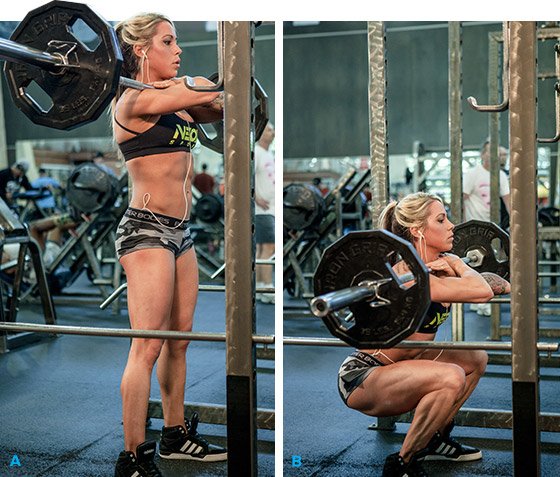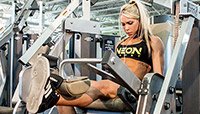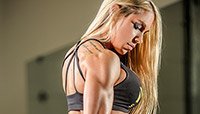Nothing kills workout motivation faster than a stale routine. Change is what pushes us to keep growing and going, so it's important to liven up your training sessions with new movements and training methods. If you're lost on how to incorporate new techniques—and add a fresh coat of gloss to your physique-carving plan—check out these tips from WBFF Pro Ashley Hoffmann.
She's given them her seal of approval and, best of all, they don't require you to undergo an entire workout overhaul. These training tips can be added to your current routine to spruce it up, offer a new take on things, or simply introduce a new method of structuring your workout.
Curious to find out more? Here are five of Ashley's favorite techniques to incorporate into your own routine. Just remember to pace yourself: These techniques are not meant to be implemented all at once; rather, use them periodically throughout your program. Check them out and see what modification best fits your training regimen!
1
Pause Sets
"I've seen great results using pause sets in my training, especially when I implement them into leg day with my squats," says Ashley.
To utilize this technique, move through the first portion of an exercise. Once you hit the final position, come to a complete stop and hold that position for a few seconds before finishing the rep. So, for a pause squat, you'd squat down, come to a complete stop at the bottom of the movement, hold it for a short count, and then explode out of the hole.

Front Squat
This does two things: First, it increases the total time the muscle is bearing weight (time under tension). Second, it prevents you from using any momentum to complete an exercise. "By using a pause set, you focus on using pure strength instead of momentum to complete your reps," Ashley explains. "I usually hold the pause at the bottom of my squat for 3-5 seconds before powering back up to the starting position."
Building explosive strength also takes some of the stress you might feel in a standard squat—from the sudden stretch-reflex action—off the knees.
When you utilize this technique, remember to maintain a regular breathing pattern. If you hold your breath the entire time, the longer sets could leave you feeling lightheaded.
2
Supersets
Ashley is also a big fan of the superset, a classic training technique that calls for you to complete two exercises back to back, without rest. While supersets are typically used with exercises for opposing muscle groups—bench press for chest paired with a row for back, for example—there are multiple variations on the basic idea.
"Supersets are a great way to raise the intensity of your workouts," Ashley says. "They can be done by working the same muscle group, opposing muscle groups, or you can even superset two totally different activities."
If Ashley's ever short on time, superset training is how she squeezes in her workout. Take note that, since you are doing twice the usual amount of work per set with this training technique, you may need to lengthen your rest periods slightly between each superset in order to recover.

3
Dropsets
Along with superset training, Ashley also likes to incorporate dropsets into her regular workout routine. "Dropsets have always been a favorite of mine for training shoulders," she says. "They really burn out the working muscle, and I seem to have the best results when I incorporate them into my workout sessions."
To use this technique yourself, perform a set of 8-12 reps at your usual working weight. When you reach the point of fatigue or failure, decrease the weight by 5-10 pounds, and immediately continue your set. When you hit failure again, you can call it good or repeat the process 1-2 more times to fully fatigue the working muscle.
When using dropsets, be sure to monitor your form with each successive set. Since your body will already be slightly fatigued from the prior set, it's important to keep an eye on maintaining proper form.
4
Running The Rack
Taking her cue from the legendary Arnold Schwarzenegger, Ashley loves to "run the rack" on specific exercises.
"Running the rack is when you choose a dumbbell exercise and start with a weight that only allows you to achieve 6 reps," Ashley explains. "After completing those 6 reps, you grab dumbbells five pounds lighter and perform 6 more reps. Continue doing this until you hit a weight where 6 reps is no longer a challenge—or no longer possible."
As with dropsets, make sure you monitor your form while doing this style of training. It's easy to let precision slip as fatigue starts to build.
5
Blood Flow Restriction Training
One often-overlooked training technique Ashley likes to incorporate into her workouts is blood flow restriction (BFR) training. BFR is best utilized when training arms or legs, specifically with dumbbell curls or leg extensions. This technique is specifically for advanced lifters.
To begin, wrap straps around the top of your biceps or inner thigh, depending on if you're training legs or arms. The straps should be tight, but not so tight that they cut off blood flow entirely. When it comes to tightness, aim for 7 out of 10 on the legs and 5 or 6 on the arms, which will restrict blood flow to the veins, but not the arteries.
"This causes the muscle to pool with blood, causing an immense amount of cell swelling," explains Ashley. "It also makes your muscles recruit larger, fast-twitch muscle fibers in order to get the job done." Both of these factors will spur muscle growth.
When using this technique, you'll lift a light weight at 20-40 percent of your one-rep max (1RM) for 3-4 sets of 15-30 reps. Rest for 30 second between sets.

Recommended For You

Ashley Hoffmann's Abs Workout: 6 Tips For Awesome Abs!
Ashley Hoffmann is the proud owner of great-looking six-pack. Here are six of her training and nutrition tips to help you carve your own awesome abdominals!
Build Legs You'll Love: Ashley Hoffmann's Leg Workout
There's nothing quite like the feeling you get after a super tough leg workout. If you haven't felt it in a while, then you need to try Ashley Hoffmann's leg smash. It's brutal, but it's exactly what you need for strong, statuesque legs!
